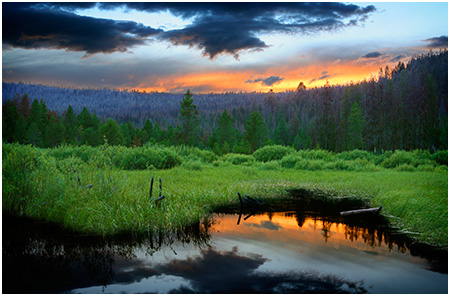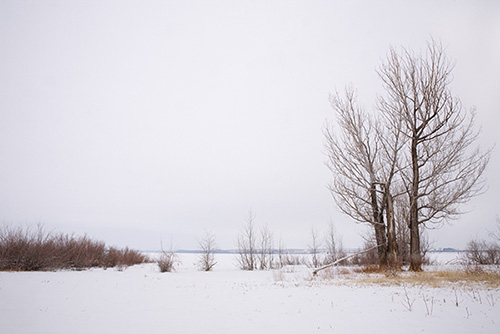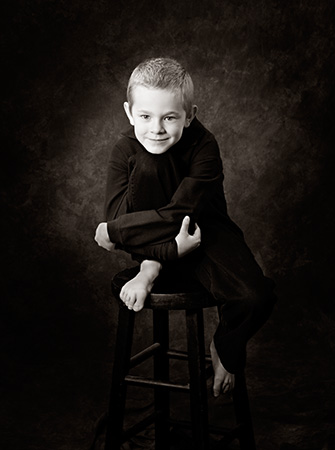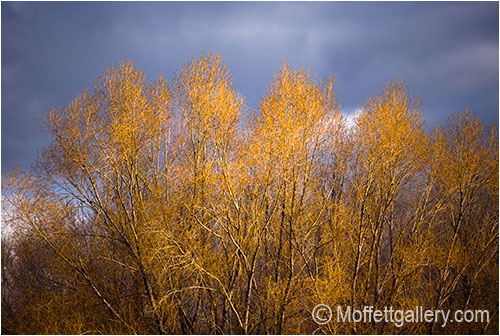by tmoffett | May 10, 2010 | Color, Composition, Critique, Photo tips, Photographic Philosophy

Rusted Hinges
I asked a class of beginning photography students today if they had done any shooting over the weekend, and I had a student reply with, “No, I don’t drive so I couldn’t go anywhere to photograph.” It brought back the memory of when I was in school and having Ruth Bernhard visit and do critiques for several of us students. She questioned, “How far did you travel to make this image.” Her point being that you don’t have to go any farther than your own backyard to find images to photograph. Be observant. Learn to really see the world.
Rusted Hinges is an image that I created without traveling. In fact, I had seen this hundreds of times before really seeing it. This scene is just outside the back door of my former studio space. I saw it every morning and evening as I came and went for nearly 10 years. One evening as I was leaving, the light just happen to be falling on the side of the building in such a way as to capture my attention. I returned to the studio to get a camera and this is what I came up with.
Look at the door. The texture of the peeling paint on the wall. The way the brick and the weeds frame the wall and door is interesting to me. But through everything that is going on in this image, the hinges, the rusty hinges of the door are what really interest me. I see decay, urban decay. This images speaks of the issues facing historic downtown areas that used to be thriving with the bustle of business, but now sit vacant and in disrepair.
The elements of this image all came together in a successful manner not because of my great photographic skills and talents, but more so because I have trained my eye to see and recognize when the elements are there. Acting upon that instinct I was able to create an image that still remains one of my favorites.
by tmoffett | May 6, 2010 | Color, Composition, Critique, Landscape, Photographic Philosophy

Sunset, Stanley Lake
Sunset, Stanley Lake is one of the first really colorful images that I have had success with. I grew up as a black and white photographer. I loved shooting large format black and white film. I developed my own film, printed my own images. The darkroom was my home. I studied Ansel Adams Zone System and felt like I had really mastered the art of black and white. The science behind it was a part of me. I no longer had to think about it, but could let the art in me come out because I knew exactly how to achieve the desired result.
Then came digital. I saw the advantages of digital first in my commercial work, so I jumped in, thinking all along that I would hang on to film for all of my personal work. It didn’t happen that way. I learned to control digital photography, not let it control me. I learned what it could and could not do. I began exploring color. That same love affair that I had initially with film was beginning to take shape with me and digital photography. In almost all of my early color work I used a very simple color palette, many times still monochromatic. That is the way I see. Then on one trip to Stanley Lake with my family, I found this image.
I had been out fishing and arrived back at camp just in time for sunset. I grabbed my camera and tripod and started walking. No more than thirty yards from our campsite I found this marshy area near the outlet. The sun had set just 10 minutes earlier and there was a haze in the sky that I later learned was caused by a wildfire that had started earlier in the day. I quickly set up and carefully composed and metered the scene. The light beautifully illuminated the haze and reflected in the water in the foreground, creating very strong color contrast in the image. The green grasses and bushes were illuminate by a wide open sky and seemed to glow. I was captivated not so much by the composition, but by the color. This was very different for me. It was an incredible feeling. I saw and felt something that I had rarely seen or felt before, and I was hooked.
I still do quite a bit of black and white work, but have now added color to my working palette. Photography for me is a journey, one that I very much enjoy. I will continue to evolve, change and grow, and as I do I will continue to share what I learn with any who wish to ride along with me!
by tmoffett | May 5, 2010 | Color, Critique, Landscape, Photo tips, Photographic Philosophy

First Snow, Lake Lowell
I love photographing in the winter. My students all think I am crazy, but I love the quiet peacefulness that exists outdoors when it is cold, especially right after the snow falls. I usually photograph solo when it is cold, as I cannot convince anyone else to brave the elements with me. Many of my winter images convey a feeling of quiet loneliness, probably due to the fact that I am out in the elements, alone. I have time to think, meditate and relax. I am not rushed by anyone or anything. For all of these reasons I am drawn to scenes that peaceful and quiet. This image is no different.
The leafless trees, the fresh-fallen snow and overcast sky work together to create a feeling of restfulness. The small cluster of trees clinging together for strength amid the open, cold world remind me of my need to build strong relationships with those I love. This bonding helps me to not only survive the winters of life but to grow through them and become stronger.
I discussed with my students yesterday how a photograph can be much more than a picture. If the image maker truly puts him/herself into their work, then their images become stronger. They begin to tell stories and create feelings and emotions. That is when we start to become artists. We are no longer documenting a scene in front of us, but we are interpreting what life throws our way in a visual way. We are opening the doors of our souls to the world and letting everyone who may to feel what we feel and see what we see. It has become my method of expressionism.
by tmoffett | May 3, 2010 | Black and White, Critique, Family, Photo tips, Portraits

Logan
In today’s post, I want to discuss a little bit about my philosophy of portrait photography. While in a fine art piece, I want everything perfect, both in the visual and in the technical aspects. In portraiture, I can give up a little perfection in order to capture a meaningful, emotional portrait, especially when it comes to children. It is all about the feeling, the memory, the inner workings of a child. This image, Logan, is a portrait of my own son, created a couple years ago, so I can discuss it both as a photographer and as a parent.
There are a few technical problems with this image that I know judges would get me for in competition, but frankly, when working with a client I really don’t care what the judges will say. I am concerned about the client. What do they want? What do they see? How can I make an image that will mean something to them? For instance, in this image, the expression is wonderful. This particular son loves to put on his “camera smile” anytime I get him in front of the camera. It is very artificial. I have many photographs of it. This time I was able to put him at ease, let him sit up on the stool and get comfortable. Before he knew it, I had the image. No time to put on the “camera face.” Just a genuine, pleasant, happy expression. I can see in his eyes the pleasant, happy child that he is. In working this way to get the perfect expression, I had neglected something else…his feet. Or had I? Yes, many a competition judge may say, “I don”t like the foot position, it is drawing too much attention.” However, what I see, is a child whose feet have outgrown the body, and now the body needs to catch up. It happens with every child. Also, the first thing to come off when my children enter the house is their shoes. They love to be barefoot. This portrait reminds me of that. Could I have covered the foot with a dark sock or shoe and pleased an audience that knows nothing about this child? Yes. But why, when it would remove some of the meaning for whom it belongs?
No matter what any critic may say, this is still one of my favorite images that I have of Logan in my collection of our family portraits. It shows me who he really is, what he is all about. The peace and joy that he brings to our home. I never tire of looking at images like this. They have meaning to me. I only hope that the portraits I create for my clients bring as much joy to them as this one does to me.
by tmoffett | May 1, 2010 | Color, Composition, Critique, Landscape, Photo tips

Evening Light, Downey, Idaho
The May Print of the Month has just been posted at MoffettGallery.com. Each month I offer a new print in an edition of only 50 prints at a 30% discount for one month only. It has proven to be a great way for many to start collecting our artwork. All images come matted and ready to frame.
This months image, Evening Light, Downey, Idaho, is another image that was created on an excursion with my wonderful wife, Christeena. Some friends invited us to meet up with them for a weekend getaway at Downata Hot Springs, and we had a great time. As we traveled to Downey, about a 6 hour drive, we found some interesting places, however the light was just not right. Shortly after arriving at the hot springs, though, the sun dropped to the horizon left us engulfed in this warm, wonderful light. Down near a pasture, just a short walk from the yurt we were staying in, I found this small grove of trees almost glowing in the light. The dark, cloudy sky made a perfect background. When looking at this image I am filled with warmth like that that radiates from the sun on a cool summer evening. With this image, I am also captivated by the lines created by the light reflecting off of the branches in the bottom third of the photograph.
The visual effectiveness of this image comes from not only the great light found that evening, but from proper selection of camera settings as well. A shallow depth of field was rendered by selecting an aperture of f2.8 and using a high shutter speed. The shallow depth of field and focus point on the near tree branches, the ones catching the light, causes them to stand out and create dimension in the image. I shoot the majority of my landscape images with a very long depth of field (f22 or more), but in this case, just the opposite was needed to make it work.
by tmoffett | Apr 28, 2010 | Black and White, Composition, Critique, Landscape

Lumbering Silence
This is one of my favorite images that I have ever created, shot near Tony Grove Lake in Cache County, Utah, a place where I spent a lot of time while attending Utah State University. I love the outdoors. The peace and quiet that the forest affords is refreshing amid the stress of daily life. When viewing this image I can almost feel the warmth of the sun on my face and hear the rustle of leaves as the cool mountain breeze blows through the trees. I can feel the protection from the elements that the tall, strong trees provide. It amazes me what a photograph can do to bring peace to the soul.
As I was walking around the lake I saw the late afternoon light pouring through these tall trees, illuminating a path wandering through the forest. The crosslight created by the low angle of the sun brings out the texture through the entire image as well as strengthens the power of the vertical lines of the trees. The light, line and texture all work together to create an image showing the strength and power, yet calming influence of nature.
Lumbering Silence, shot on film, is available as a handprinted gelatin silver print in sizes up to 8.5″x18″ inches, and larger prints as archival injet prints.








Recent Comments